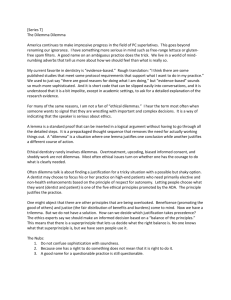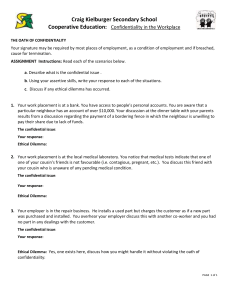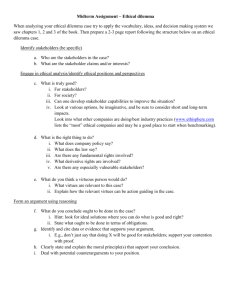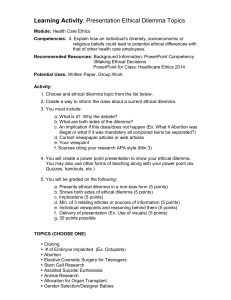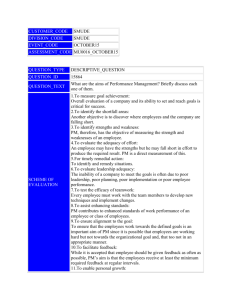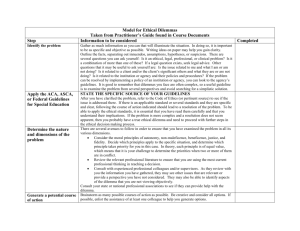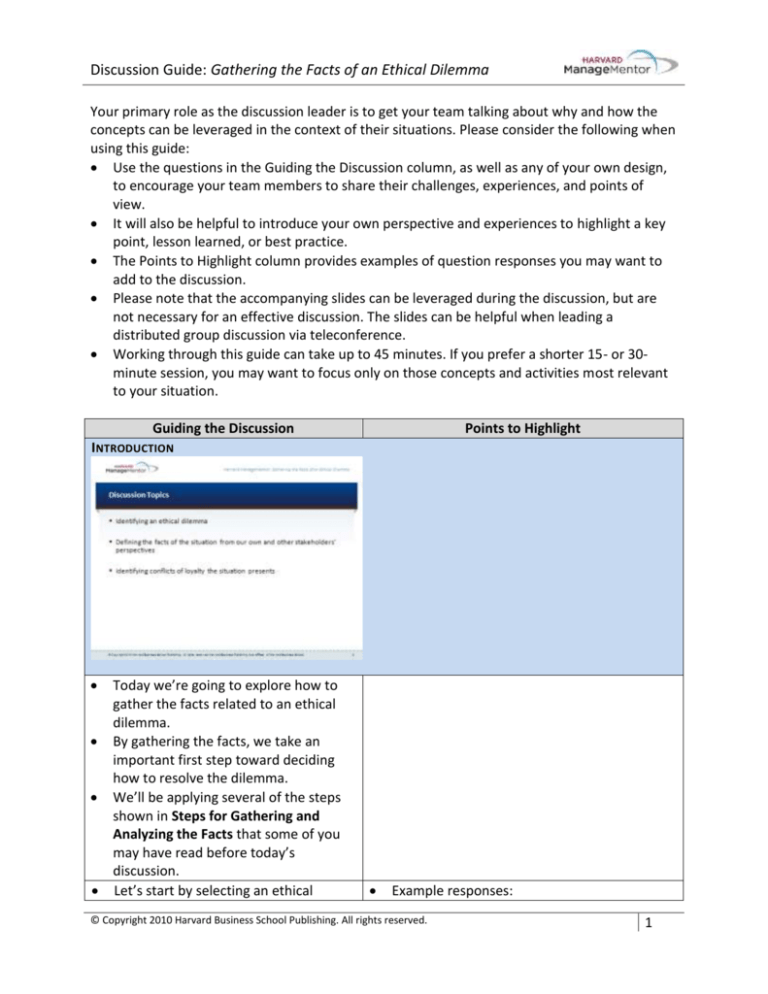
Discussion Guide: Gathering the Facts of an Ethical Dilemma
Your primary role as the discussion leader is to get your team talking about why and how the
concepts can be leveraged in the context of their situations. Please consider the following when
using this guide:
Use the questions in the Guiding the Discussion column, as well as any of your own design,
to encourage your team members to share their challenges, experiences, and points of
view.
It will also be helpful to introduce your own perspective and experiences to highlight a key
point, lesson learned, or best practice.
The Points to Highlight column provides examples of question responses you may want to
add to the discussion.
Please note that the accompanying slides can be leveraged during the discussion, but are
not necessary for an effective discussion. The slides can be helpful when leading a
distributed group discussion via teleconference.
Working through this guide can take up to 45 minutes. If you prefer a shorter 15- or 30minute session, you may want to focus only on those concepts and activities most relevant
to your situation.
Guiding the Discussion
Points to Highlight
INTRODUCTION
Today we’re going to explore how to
gather the facts related to an ethical
dilemma.
By gathering the facts, we take an
important first step toward deciding
how to resolve the dilemma.
We’ll be applying several of the steps
shown in Steps for Gathering and
Analyzing the Facts that some of you
may have read before today’s
discussion.
Let’s start by selecting an ethical
Example responses:
© Copyright 2010 Harvard Business School Publishing. All rights reserved.
1
Discussion Guide: Gathering the Facts of an Ethical Dilemma
Guiding the Discussion
dilemma our team is currently facing or
has faced in the past.
Then we’ll talk about how to define the
facts of the situation from our own
perspective and from other
stakeholders’ perspectives.
We’ll also consider the conflicts of
loyalty the situation brings up.
Let’s identify an ethical dilemma to
work on. Who can think of an ethical
dilemma that might be interesting to
discuss?
Points to Highlight
o One of our suppliers just sent our
team a holiday gift that’s more
expensive than what our company’s
code of conduct stipulates. We’ve
worked with this company a long time,
and it seems rude to refuse the gift.
But technically, accepting it would
violate the rules.
o We’re trying to enter a new market
with the product we’re developing,
and it would be great to find out how
much our competitors are charging for
similar products. Someone suggested
posing as a prospective customer for
these companies to get pricing
information. Someone else said that
would be unethical.
Note: If team members are having difficulty
identifying an ethical dilemma to work on,
suggest one of which you are aware. If
necessary, choose a past ethical dilemma to
review.
DEFINING THE FACTS FROM OUR TEAM’S PERSPECTIVE (15 MINUTES)
Choose one ethical dilemma to discuss,
preferably one that is current.
We’ve picked an ethical dilemma to
work on. What are all the relevant
facts we know about this dilemma?
Example responses (for the supplier gift
example dilemma):
o Our company’s code of conduct
stipulates that gifts from suppliers
cannot exceed $30 in value. The gift
from this supplier has a value that
© Copyright 2010 Harvard Business School Publishing. All rights reserved.
2
Discussion Guide: Gathering the Facts of an Ethical Dilemma
Guiding the Discussion
Points to Highlight
exceeds $30.
o The supplier is based in Japan. Giftgiving protocols there are different
from here.
Note: Use an easel or whiteboard to list
group members’ responses. Translate
emotionally charged comments into
neutral language. For example, don’t write,
“This supplier is being sneaky — he’s trying
to secure future business with us by giving
us lavish gifts.” Instead write, “The
supplier’s gift has a value that’s more than
what our company’s code of conduct
stipulates.”
List these separately.
Example responses (for the supplier gift
example dilemma):
o We don’t know whether our company
has made exceptions to the gift-giving
rule in the past.
o We don’t know if the company’s code
of conduct has been updated to reflect
increases in the value of gifts.
What are all the facts we don’t know
about this dilemma?
What could we do to gather the facts
that we don’t know about this
dilemma?
Example response:
o Talk with the experts in our company
who developed and maintain the
published code of conduct to find out
whether making exceptions is okay
under some circumstances or if the
information in the code is up-to-date.
DEFINING THE FACTS FROM OTHER STAKEHOLDERS’ PERSPECTIVES (15 MINUTES)
© Copyright 2010 Harvard Business School Publishing. All rights reserved.
3
Discussion Guide: Gathering the Facts of an Ethical Dilemma
Guiding the Discussion
We’ve defined the facts of this
dilemma from our own perspective.
Who are the other stakeholders in this
dilemma?
How would each of these stakeholders
define the facts of the situation?
Points to Highlight
Example responses:
o In addition to our team, the other
stakeholders include the supplier in
question, as well as other suppliers we
use.
o Employees in other groups that didn’t
get gifts.
Note: Encourage team members to think
broadly about stakeholders: Identify everyone
who would be affected by the final course of
action the team selects to resolve this
dilemma.
Example responses:
o Our Japanese supplier might say
something like, “Gift-giving is a core
component of how we traditionally do
business.”
o Our other suppliers might say, “On
two occasions when we have not given
gifts to customers, we have lost them
to competitors.”
o Employees who work in departments
that didn’t receive gifts from suppliers
might say, “We didn’t get gifts, while
other departments did.”
Note: Suggest that team members put
themselves in each stakeholder’s shoes — that
is, imagine what the stakeholder’s business
challenges and priorities are.
© Copyright 2010 Harvard Business School Publishing. All rights reserved.
4
Discussion Guide: Gathering the Facts of an Ethical Dilemma
Guiding the Discussion
IDENTIFYING CONFLICTS OF LOYALTY (15 MINUTES)
Points to Highlight
Who are the various parties we feel
loyalty to in trying to resolve this
dilemma?
Example responses:
o The company
o The team
o The supplier in question
o Other suppliers the team uses
o Other employees
o The industry in general
How are these feelings of loyalty
coming into conflict?
Example response: I want to honor our
company’s gift-giving protocols. But we’ve
worked with this supplier for a long time, and
they’ve done a great job for us. If we decline
their gift, it might damage the relationship.
But if we accept it, we might alienate other
suppliers.
What do these conflicts of loyalty
suggest about which of our values
mean the most to us?
Example response:
o The fact that I feel most
uncomfortable about alienating our
suppliers suggests that, for me,
maintaining strong relationships with
our business partners is a priority
value.
© Copyright 2010 Harvard Business School Publishing. All rights reserved.
5
Discussion Guide: Gathering the Facts of an Ethical Dilemma
Guiding the Discussion
Points to Highlight
NEXT STEPS
Take a moment to consider some of
the things you might do as a result of
our discussion today.
The next time you encounter an ethical
dilemma, partner with several
colleagues and practice gathering the
facts: Define the facts from your
perspective and from other
stakeholders’ perspectives, and
identify the conflicts of loyalty the
situation raises. Use the Steps for
Gathering and Analyzing the Facts as a
guide.
If you haven’t already done so, take a
few moments to complete the activity
How Ethical Are You? in the Learn
section of the Ethics at Work topic.
Note: Consider leading a discussion on
Evaluating and Testing a Proposed Solution to
an Ethical Dilemma as a follow-on activity to
this discussion.
© Copyright 2010 Harvard Business School Publishing. All rights reserved.
6



